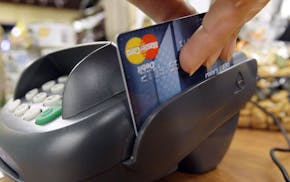Not much has changed about the Holidazzle parade since it first snaked its way down the Nicollet Mall in 1992.
The same can't be said about the downtown Minneapolis retail scene. It has gotten smaller, less interesting and less ambitious.
Here is a partial list of merchants who've disappeared during the past 20 years: Carson's, Wards, Room and Board, Saks Fifth Avenue, Crate and Barrel, Williams-Sonoma, Polo, Burberry's, Brentano's Bookstore, Badiner Jewelers, T.J. Maxx.
Then there are the retailers who never came, like Nordstrom or Best Buy, despite insistent wooing.
Before going any further, let's state the obvious: By many measures, Minneapolis has a vibrant, lively downtown. An estimated 165,000 people work downtown, and another 35,000 live there. Just try to get an early-evening seat or table at many of the bars and restaurants that line Nicollet Mall, or to wade through the throngs in the Warehouse District on nights when the Twins are playing a home game.
So, we're not talking Brookdale, the Brooklyn Center regional mall that was demolished earlier this year.
People still shop in downtown Minneapolis, but fewer of them seem to make a point of going downtown to shop.
Every year, University of St. Thomas professor Dave Brennan, co-director of the school's Institute for Retailing Excellence, asks Twin Cities area consumers how much they plan to spend during the holidays, and where they will do most of their shopping.
This year, more than 21 percent chose Rosedale, followed closely by Mall of America.
The market share for downtown Minneapolis: about 2 percent.
"That puts it on a par with Northtown and some of the weaker or older shopping centers in our survey," Brennan said.
Ouch.
This shrinking of downtown retail has played out in most cities around the country. Some, such as Chicago, New York and San Francisco, maintain vibrant and diverse retail scenes because they serve bigger local populations and draw millions of tourists each year.
Minneapolis has put up a valiant fight. It built the Nicollet Mall. It subsidized City Center. It subsidized the Conservatory -- an upscale mini-center on the Nicollet Mall that opened, closed and was demolished in less than a decade. It threw public money at Riverplace, St. Anthony Main, Gaviidae Common and the new Target store. It even tried to subsidize a French development firm that promised to bring Nordstrom downtown if it could build a dome over one end of the Nicollet Mall.
But in most instances, efforts here and elsewhere were not enough to blunt inexorable demographic and economic trends. As people and then companies moved to the suburbs, where land and space was cheaper and more plentiful, retailers and developers followed. As consumer tastes changed, department stores -- the retail anchor for most downtowns -- lost their dominance.
Downtowns became just another mall, only harder to get to, more tiring to walk and more costly to park.
The arrival of the Mall of America in 1992 galvanized Minnesota retailers. The owners of Ridgedale, Southdale and Rosedale embarked on ambitious remodeling efforts. Downtown Minneapolis pumped more than $1 million into a new marketing campaign, which included the Holidazzle parade and a discounted parking validation scheme, and it stepped up its retail recruiting efforts.
But the downtown exodus did not stop. In 1998, there were 183 retail establishments in the 55402 ZIP code, which encompasses much of the central business district. By 2009 there were 94, a trend that might exhaust even the most tireless downtown booster.
About 23 percent of the retail space in downtown Minneapolis is vacant, but the firm that compiles that data, Cushman & Wakefield/NorthMarq, cautions against putting too much stock in that number. The survey doesn't include buildings under a certain size, or some buildings occupied by single retail tenant.
"Downtown retail is a difficult beast to get your arms around," said Ned Rukavina, a senior vice president with the firm.
After a spate of downtown merchant departures in 2007, the Minneapolis Downtown Council hired a new retail recruiter. She left the organization two years later. The council's CEO, Sam Grabarski, did not respond to an interview request.
Meanwhile, organizers have reduced the frequency of the Holidazzle parade between Thanksgiving and Christmas, from 21 times to 15, and the validated parking program is no longer in place.
The past several years have been tough on all retailers. Those that didn't go bankrupt were forced to close underperforming stores and limit new store openings to the strongest markets or regional centers, including the Mall of America.
Downtown Minneapolis no longer appears to be on that list.
ericw@startribune.com • 612-673-1736

Wieffering: Time to get over debit card fees
For Thrivent and others, warnings were there

With billions in sales, some co-ops are big business
